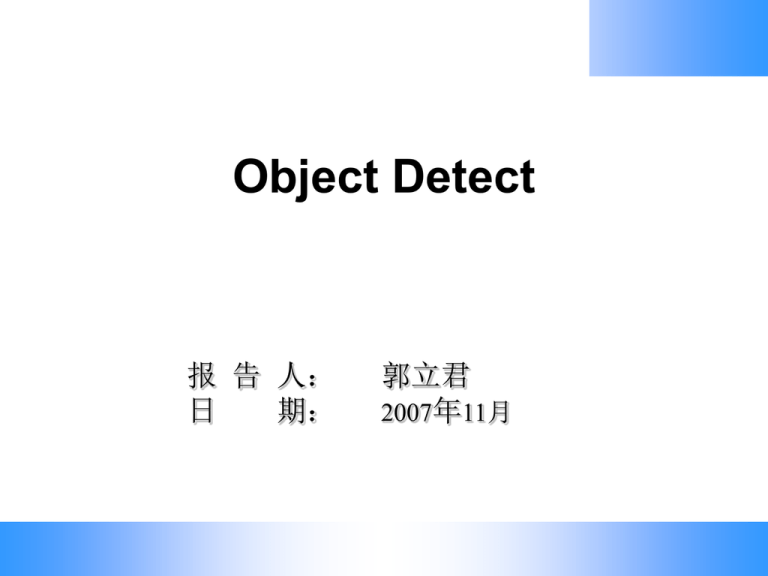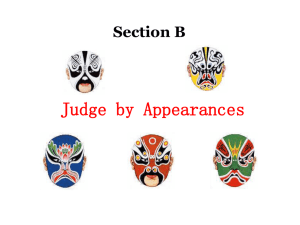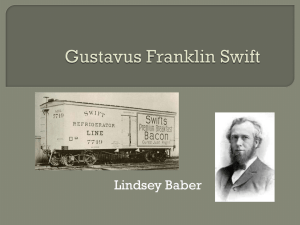Dressed Human Modeling
advertisement

Object Detect 报 告 人: 日 期: 郭立君 2007年11月 Contents • • • • Introduction Rigid Object Detect Human Detect Introduction Histograms of Oriented Gradients for Human Detection • Dressed Human Modeling,Detection • Conclution Introduction • Some Background on Object Detection As mentioned earlier an object detector can be viewed as a combination of an image feature set and a detection algorithm. 1.The image descriptors or feature vectors that they use 2.The detection framework that is built over these descriptors Introduction • Descriptors or Feature Vectors Sparse Local Representations Point Detectors (SIFT etc) Part or Limb Detectors Dense Representation of Image Regions Regions and Fragments Based on Image Intensity Edge and Gradient Based Detectors Wavelet Based Detectors Introduction • Classfication Method Generative Approaches: Typically generative approaches use Bayesian graphical models with Expectation-Maximisation (EM) to characterise these parts and to model their cooccurrences. Such as Bayesian and Graphical Models Discriminative Approaches: Discriminative approaches use machine learning techniques to classify each feature vector as belonging to the object or not. Such as Support Vector Machine (SVM) Classifiers and Cascaded AdaBoost Rigid Object Detection • Roberts’ Method Rigid Object Detection • Model Based Vehicle Motion(Tieniu Tan) Human Detect Introduction Challenges • Wide variety of articulated poses • Variable appearance/clothing • Complex backgrounds • Unconstrained illumination • Occlusions, different scales Human Detect Introduction Applications • Pedestrian detection for smart cars • Film & media analysis • Visual surveillance • Mobile robot navigation • Human motion capture Note Two approaches to object detection One approach is to search the whole image at multi-scales for objects. This is a time consuming procedure and may result in multiple responses from a single object. Another approach is to first segment foreground objects from the background,then classify each segmented object as human or non-human. Dressed Human Modeling,Detection --Liang Zhao CMU-RI-TR-01-19 • Backgroud Dressed Human Modeling,Detection • Backgroud Dressed Human Modeling,Detection • Goal (a)initial contour detection (b) body parts identification (c) contour prediction (d) contour alignment Dressed Human Modeling,Detection • Goal focuses on how to classify a previously segmented object as human or non-human • Idea Rrecognition scheme is based on the shapes of body parts and the relationships between them. Then the questions left are how to decompose a silhouette into parts, and how to represent the shapes and the relationships between the parts Dressed Human Modeling • Requirements for a Good Object Class Model 1. It should not depend on scale, orientation, and position of objects; 2. It should handle view-dependent shape variation; 3. It should be robust to shape distortions resulting from digitization noise and foreground/background segmentation errors; 4. It should be robust to partial occlusions of an object; 5. It should allow for articulated moving parts; 6. It should not be influenced by the shape variations allowed within the class; 7. It should support efficient shape recognition/classification. Dressed Human Modeling • Shape Decomposition for Part-Based Representation Dressed Human Modeling • Shape Decomposition for Part-Based Representation Dressed Human Modeling • Shape Decomposition for Part-Based Representation Dressed Human Modeling • Shape Decomposition for Part-Based Representation Problems and Solutions: (a) Smooth the boundary of a silhouette. (b) Remove noise or small local deformations (c) Exploit high level information(RCR) Dressed Human Modeling • Human body model TRS-invariant probabilistic model: For the purpose of human detection and model learning, a TRS-invariant representation of the shapes of parts and the relationships between them is developed. For the purpose of modeling the shape variations between individuals and due to viewpoint changes, probability distributions are employed to encode the variations of the model parameters. Dressed Human Modeling • Human body model Dressed Human Modeling • Human body model A body part is parameterized with a vector (a; l; x; y;Ө), where a = w/l is the aspect ratio that captures the general shape of a ribbon, (x; y) are the coordinates of the origin in the coordinate frame of the parent part, and Ө is the intersection angle between the major axes of this part and its parent part. Dressed Human Modeling • Human body model Three TRS-invariant matrices: A; S; U, Dressed Human Modeling • Human body model TRS-invariant probabilistic model: Dressed Human Modeling • Dressed Human Modeling Dressed Human Modeling • Dressed Human Modeling 1.Merged body parts(dynamic) 2.An evaluation function( Bayesian similarity measure-Shape Similarity Measure) 3.A coarse to fine procedure( RCR algorithmrecursive context reasoning) Dressed Human Modeling • Dressed Human Modeling TRS BSM Dressed Human Modeling • Bayesian Similarity Measure and Body Part Identification Problem Formulation: Dressed Human Modeling • Bayesian Similarity Measure and Body Part Identification Problem Formulation: Dressed Human Modeling • Bayesian Similarity Measure for Human Detection Decision Rule: Dressed Human Modeling • Bayesian Similarity Measure for Human Detection Resule: Histograms of Oriented Gradients for Human Detection Background INRIA Rhˆone-Alpes 1. Focus on building robust feature sets 2. Classifier is just linear SVM on normalized image windows, is reliable & fast 3. Moving window based detector with nonmaximum suppression over scale-space Histograms of Oriented Gradients for Human Detection Background Histograms of Oriented Gradients for Human Detection Feature Sets Histograms of Oriented Gradients for Human Detection Processing Chain Histograms of Oriented Gradients for Human Detection HOG Descriptors Histograms of Oriented Gradients for Human Detection Performance Histograms of Oriented Gradients for Human Detection Descriptor Cues Histograms of Oriented Gradients for Human Detection Conclusions Histograms of Oriented Gradients for Human Detection Demo the question should be: y = arg max h(a1,a2,...,an) for example: if ai maximizes h, y = ai








